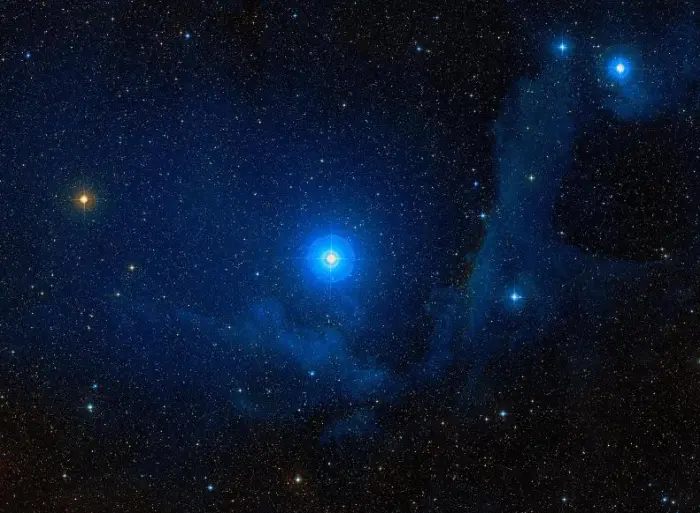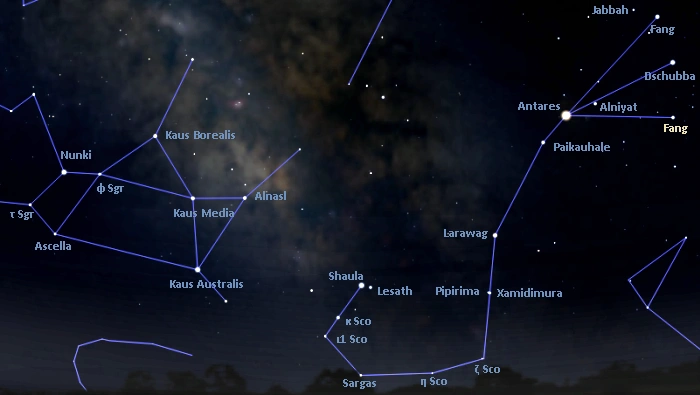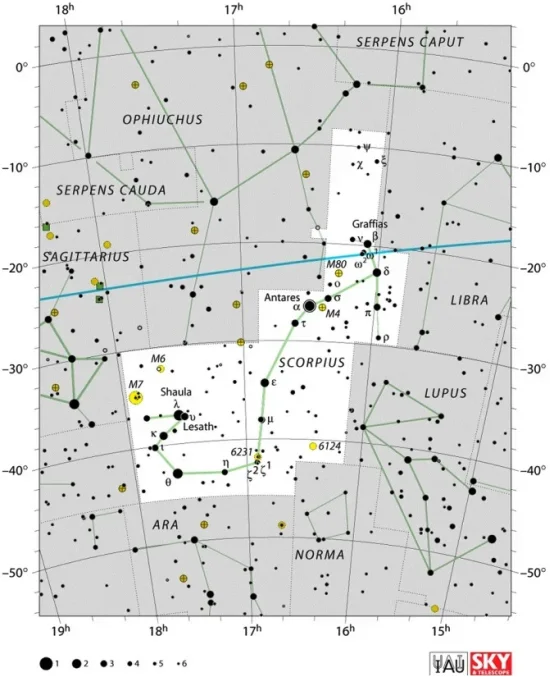Fang, Pi Scorpii (π Sco), is a massive blue star in a triple star system located approximately 590 light years away in the constellation Scorpius. With an apparent magnitude of 2.890, it is the 10th brightest star in the constellation. It is part of the Scorpion’s claws, a prominent asterism visible throughout the summer months in the northern hemisphere.
Star system
Pi Scorpii is a triple star system composed of a close binary pair, Pi Scorpii A, and a more distant companion, Pi Scorpii B. The visual component Pi Scorpii A consists of two stars, Pi Scorpii Aa and Pi Scorpii Ab, that form an eclipsing binary system of the Beta Lyrae type. The system has an orbital period of only 1.570103 ± 0.000005 days, and the components are separated by only 0.07 astronomical units (7% of the distance from the Earth to the Sun), or 15 solar radii.
Pi Scorpii Aa and Ab are both hot blue main sequence stars. They have the spectral types B1V and B2V.
Pi Scorpii Aa has a mass 12.5 times that of the Sun and a radius of 5 solar radii. With an effective temperature of 25,230 K, it is 21,900 times more luminous than the Sun. It spins at 108 km/s. The star has an estimated age of 12 – 15.4 million years. It is a supernova candidate.
Pi Scorpii Ab has a mass of 9 solar masses and a radius of 4 solar radii. It has a surface temperature of 21,000 K and shines with 3,000 solar luminosities. It spins with a projected rotational velocity of 87 km/s. When it reaches the end of its life cycle, the star may go out as a supernova or it may expel its outer layers to form a planetary nebula, leaving behind a massive white dwarf. However, in such a close binary system, the stars may not follow a normal evolutionary path.
The main component of the Pi Scorpii system is a Beta Lyrae-type eclipsing binary star that displays an ellipsoidal variation of 0.03 magnitudes. Beta Lyrae stars are variable stars whose brightness varies because the two components eclipse each other as they orbit around a common centre of mass. They are massive binary systems that orbit so close to each other that their shapes are distorted by mutual gravity.
These are mostly evolved giant or supergiant stars that have ellipsoidal shapes and easily lose mass because of their size. In such close systems, there are mass flows from the more massive component to the companion. The more massive star is the first to expand into a giant or supergiant and it starts to lose mass because of weaker gravity and a strong stellar wind.
Other relatively bright stars in this class include the class prototype Beta Lyrae (Sheliak) in the constellation Lyra, Tau Canis Majoris in Canis Major, and Xamidimura (Mu1 Scorpii) in Scorpius.
Pi Scorpii A has a smaller, fainter, more distant companion, designated Pi Scorpii B. The fainter star has an apparent visual magnitude of 12.2 and is invisible to the unaided eye. It appears 50 arcseconds from the main pair, corresponding to a physical separation of at least 7,000 astronomical units.
Pi Scorpii B is likely a K-type dwarf, but its physical properties are uncertain. It may have a dimmer companion at a separation of around 90 AU, with an orbital period of over 160,000 years.

Fang (Pi Scorpii), image credit: ESO/Digitized Sky Survey 2 (CC BY 4.0)
Pi Scorpii nebula
The Pi Scorpii star system illuminates a large nebula about 80 light-years across. The nebula is catalogued as Sharpless 2-1 (Sh2-1), vdB 99 and LBN 1093. It both reflects the light of the bright stars and is ionized by their ultraviolet radiation into emitting its own light.
The faint nebula was discovered by the American astronomer Edward Emerson Barnard on photographic plates in 1894. Barnard later exposed a photographic plate using the Bruce Photographic Telescope at Yerkes Observatory on Mount Wilson, which revealed a nebula 4.5 by 5 degrees across.
American astronomer Stewart Sharpless found the Pi Scorpii nebula on the plates obtained with the 48-inch Schmidt telescope as part of the Palomar Observatory Sky Survey in the late 1950s. He included the nebula in his catalogue of H II regions in 1959. He noted that Pi Scorpii was the source of excitation of the nebula.
Dutch-Canadian astronomer Sidney van den Bergh listed the nebula in his Catalog of Reflection Nebulae of 1966.

The binary star system Rho Ophiuchi. This star-forming region is located only 400 light years from Earth and is surrounded by a red emission nebula and numerous light and dark brown dust lanes. Nearby is the star Antares while the globular cluster, M4, is visible between Antares and the red emission nebula. Toward the bottom can be found IC 4592, the Blue Horsehead Nebula. Note: the stars in this image appear large and white rather than in their true colors due to overexposure, and the image is much more luminous than in reality (with normal computer screen settings). Antares is the white dot in the yellow area. North is towards the bottom. M4 is to the left of Antares, and Sigma Scorpii is to the lower left of M4, in the red area. These three objects form three corners of a pentagon. The other two corners, proceeding counterclockwise, are HD 147889 (near IC 4603) and 22 Scorpii. Far to the left of the pentagon is Pi Scorpii and lower down Dschubba and Acrab, three prominent stars in the head and claws of the Scorpion. The multiple star system Rho Ophiuchi itself appears as three white dots in the middle of the blue area just below the pentagon. Image credit: Rogelio Bernal Andreo (CC BY-SA 3.0)
Facts
Pi Scorpii is a member of the Upper Scorpius subgroup of the Scorpius-Centaurus OB association (Sco OB2). Sco OB2 is the nearest association of hot, blue O- and B-type stars to the Sun. Members of Upper Scorpius are young blue stars with an average age of 11 million years, located at an average distance of 550 light years. Other bright members of the group include Antares (Alpha Scorpii), Alniyat (Sigma Scorpii), Dschubba (Delta Scorpii), Paikauhale (Tau Scorpii), Acrab (Beta Scorpii), Iklil (Rho Scorpii) and Pipirima (Mu2 Scorpii) in Scorpius and Zeta Ophiuchi in the neighbouring Ophiuchus.
Fang shines at magnitude 2.89 and is, on average, the 154th brightest star in the night sky. It is only slightly fainter than Alpha Tucanae in the constellation Tucana and Acamar (Theta Eridani) in Eridanus. It is about as bright as Albaldah (Pi Sagittarii) in Sagittarius, Gomeisa (Beta Canis Minoris) in Canis Minor, Epsilon Persei in Perseus, and Sadalsuud (Beta Aquarii) in Aquarius, and only imperceptibly brighter than its Scorpius neighbour Alniyat (Sigma Scorpii) and Albireo (Beta Cygni) in Cygnus.
Pi Scorpii forms the brighter portion of the Scorpion’s claws with Acrab (Beta Scorpii) and Dschubba (Delta Scorpii). The three stars are easily visible from most locations on a clear night for at least part of the year. They appear west of the bright Antares, the star that marks the Scorpion’s heart.
Pi Scorpii was discovered to be a binary star by American astronomer Edward Charles Pickering in 1899. In 1902, American astronomer Solon Irving Bailey found an orbital period of 1.571 days for the system. Russian astronomer Otto Struve and American astrophysicist Christian T. Elvey calculated the precise orbit for the system in 1927.
Name
The name Fang comes from the traditional Chinese name for Pi Scorpii. The International Astronomical Union’s (IAU) Working Group on Star Names (WGSN) formally approved the name on June 30, 2017. The name officially applies only to the primary component, Pi Scorpii Aa.
In old Chinese astronomy, Pi Scorpii was known as 房宿一 (Fáng Xiù yī), the First Star of Room. It formed the Room asterism with Iklil (Rho Scorpii), Dschubba (Delta Scorpii), and Acrab (Beta Scorpii). The asterism was part of the larger Room mansion and represented the belly of the Azure Dragon.
Location
Pi Scorpii is very easy to find because it is part of a prominent star pattern, the Scorpion’s claws. It is the southernmost of the three bright stars in the claws and appears just west of Antares.

Location of Pi Scorpii (Fang), image: Stellarium
Constellation
Fang is located in the constellation of Scorpius. The celestial Scorpion is one of the 48 Greek constellations, catalogued by Claudius Ptolemy of Alexandria in the 2nd century CE. In Greek mythology, the constellation is associated with the scorpion sent by Gaia, the goddess of the Earth, to sting the giant huntsman Orion.
Scorpius is one of the 12 zodiac constellations, which lie on the ecliptic, the Sun’s apparent path across the sky. These constellations are invisible for about a month each year when the Sun appears to pass through them.
The Scorpion occupies an area of 497 square degrees of the southern sky and is the 33rd largest of the 88 modern constellations. It is one of the brightest constellations, as well as one of the most recognizable. Like Leo, it looks like the animal it represents. The constellation’s brightest stars form an asterism called the Fish Hook, which corresponds to the Scorpion’s body, tail and stinger.
Scorpius is best-known for being home to Antares, the 15th brightest star in the sky. The variable red supergiant shines at magnitude 0.6 – 1.6 from an approximate distance of 550 light years. It is the only first magnitude star in Scorpius.
The second magnitude stars in the constellation are the blue subgiants Shaula (Lambda Scorpii) and Dschubba (Delta Scorpii), the yellow-white giant Sargas (Theta Scorpii), the orange giant Larawag (Epsilon Scorpii), and the variable blue giant Kappa Scorpii. With the exception of Larawag, these stars are members of binary or multiple star systems.
Other notable stars in Scorpius include the hot blue main sequence stars Paikauhale (Tau Scorpii), Acrab (Beta Scorpii), Jabbah (Nu Scorpii) and Xamidimura (Mu1 Scorpii), the blue subgiants Lesath (Upsilon Scorpii) and Pipirima (Mu2 Scorpii), the blue giant Alniyat (Sigma Scorpii), the orange giant Zeta2 Scorpii, the blue hypergiant Zeta1 Scorpii, and the white supergiant Iota1 Scorpii.

Scorpius constellation map by IAU and Sky&Telescope magazine (Roger Sinnott & Rick Fienberg) (CC BY 3.0)
Scorpius also contains the nova T Scorpii, the red supergiant AH Scorpii, one of the largest stars known, the blue supergiant Pismis 24-1 and the candidate luminous blue variable Wray 17-96, both among the most luminous stars known, and the yellow hypergiant IRAS 17163-3907, the central star of the Fried Egg Nebula (Hen 3-1379).
Deep sky objects in the Scorpion constellation include the globular clusters Messier 4 and Messier 80, the open clusters Messier 6 (the Butterfly Cluster) and Messier 7 (the Ptolemy Cluster), the Northern Jewel Box Cluster (NGC 6231), the Lobster Nebula (NGC 6357), the Cat’s Paw Nebula (NGC 6334), the Butterfly Nebula (NGC 6302), the Blue Horsehead Nebula (IC 4592), and the Cotton Candy Nebula.
The best time of the year to observe the stars and deep sky objects in Scorpius is during the month of July, when the constellation climbs higher above the horizon around 9 pm. The entire constellation can be seen from locations south of the latitude 40° N.
The 10 brightest stars in Scorpius are Antares (Alpha Sco A, mag. 0.6 – 1.6), Shaula (Lambda Sco A, mag. 1.62), Sargas (Theta Sco A, mag. 1.84), Dschubba (Delta Sco, mag 2.307), Larawag (Epsilon Sco, mag. 2.31), Kappa Scorpii (mag. 2.39), Acrab (Beta Sco, mag. 2.62), Lesath (Upsilon Sco, mag. 2.70), Paikauhale (Tau Sco, mag. 2.82), and Fang (Pi Sco, mag. 2.89).
Fang – Pi Scorpii
| Spectral class | B1 V + B2 V |
| Variable type | Eclipsing binary (Beta Lyrae) |
| U-B colour index | −0.918 |
| B-V colour index | −0.187 |
| Apparent magnitude | 2.890 |
| Absolute magnitude | −3.35 |
| Distance | 590 light-years (180 parsecs) |
| Parallax | 5.57 ± 0.64 mas |
| Radial velocity | -7.40 ± 1.3 km/s |
| Proper motion | RA: −11.42 ± 0.78 mas/yr |
| Dec.: −26.83 ± 0.74 mas/yr | |
| Constellation | Scorpius |
| Right ascension | 15h 58m 51.1132378s |
| Declination | −26° 06′ 50.788602″ |
| Names and designations | Fang, Pi Scorpii, Pi Sco, π Scorpii, π Sco, 6 Scorpii, 6 Sco, HD 143018, HR 5944, HIP 78265, SAO 183987, FK5 592, CD−25°11228, CPD-25 5705, CEL 4409, CSI-25 11228 21, CSI-25 11228 23, CSV 102782, GC 21447, GCRV 9190, SKY# 28841, PLX 3611, NSV 7371, GEN# +1.00143018A, PPM 264940, GSC 06783-02697, HGAM 2045, PMC 90-93 422, SHT 60, AKARI-IRC-V1 J1558507-260648, ALS 14814, MCW 555, N30 3584, SACS 347, SBC7 556, SBC9 873, ROT 3519, WISEA J155851.10-260651.1, JP11 2691, uvby98 100143018 A, IRAS 15557-2558, IRAS F15557-2558, 2MASS J15585111-2606507, SRS 30592, TD1 18718, TIC 66744681, VDB 99, WEB 13235, TYC 6783-2697-1, Gaia DR2 6235406071206201600, Gaia DR3 6235406071207202688, UBV 13549, UBV M 21062, BU 622A, ADS 9862 A, CCDM J15589-2607A, IDS 15528-2550 A, WDS 15589-2607, WDS J15589-2607Aa,Ab |
Pi Scorpii Aa
| Spectral type | B1V |
| Mass | 12.5 ± 0.6 M☉ |
| Luminosity | 21,900 L☉ |
| Radius | 5 R☉ |
| Temperature | 25,230 K |
| Age | 15.4 ± 0.6 million years; 12 – 14 Myr |
| Rotational velocity | 108 km/s |
Pi Scorpii Ab
| Spectral type | B2V |
| Mass | 9 M☉ |
| Luminosity | 3,000 L☉ |
| Radius | 4 R☉ |
| Temperature | 21,000 K |
| Rotational velocity | 87 km/s |